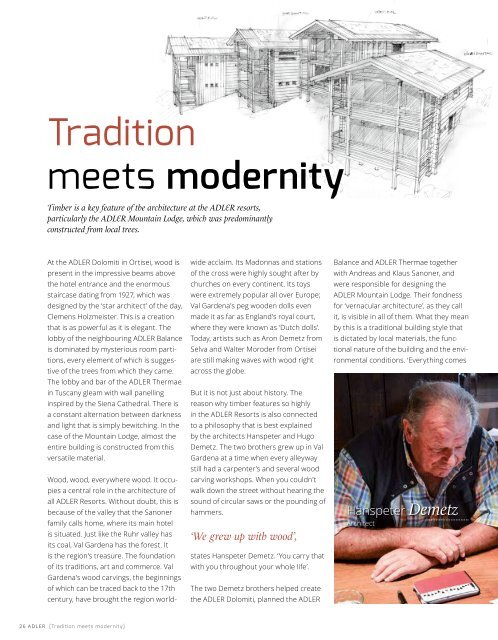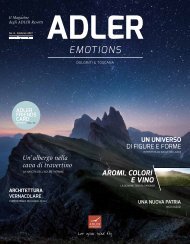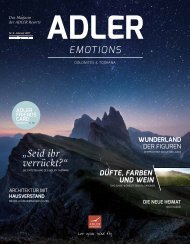You also want an ePaper? Increase the reach of your titles
YUMPU automatically turns print PDFs into web optimized ePapers that Google loves.
Tradition<br />
meets modernity<br />
Timber is a key feature of the architecture at the <strong>ADLER</strong> resorts,<br />
particularly the <strong>ADLER</strong> Mountain Lodge, which was predominantly<br />
constructed from local trees.<br />
At the <strong>ADLER</strong> Dolomiti in Ortisei, wood is<br />
present in the impressive beams above<br />
the hotel entrance and the enormous<br />
staircase dating from 1927, which was<br />
designed by the ‘star architect’ of the day,<br />
Clemens Holzmeister. This is a creation<br />
that is as powerful as it is elegant. The<br />
lobby of the neighbouring <strong>ADLER</strong> Balance<br />
is dominated by mysterious room partitions,<br />
every element of which is suggestive<br />
of the trees from which they came.<br />
The lobby and bar of the <strong>ADLER</strong> Thermae<br />
in Tuscany gleam with wall panelling<br />
inspired by the Siena Cathedral. There is<br />
a constant alternation between darkness<br />
and light that is simply bewitching. In the<br />
case of the Mountain Lodge, almost the<br />
entire building is constructed from this<br />
versatile material.<br />
Wood, wood, everywhere wood. It occupies<br />
a central role in the architecture of<br />
all <strong>ADLER</strong> Resorts. Without doubt, this is<br />
because of the valley that the Sanoner<br />
family calls home, where its main hotel<br />
is situated. Just like the Ruhr valley has<br />
its coal, Val Gardena has the forest. It<br />
is the region’s treasure. The foundation<br />
of its traditions, art and commerce. Val<br />
Gardena’s wood carvings, the beginnings<br />
of which can be traced back to the 17th<br />
century, have brought the region worldwide<br />
acclaim. Its Madonnas and stations<br />
of the cross were highly sought after by<br />
churches on every continent. Its toys<br />
were extremely popular all over Europe;<br />
Val Gardena’s peg wooden dolls even<br />
made it as far as England’s royal court,<br />
where they were known as ‘Dutch dolls’.<br />
Today, artists such as Aron Demetz from<br />
Selva and Walter Moroder from Ortisei<br />
are still making waves with wood right<br />
across the globe.<br />
But it is not just about history. The<br />
reason why timber features so highly<br />
in the <strong>ADLER</strong> Resorts is also connected<br />
to a philosophy that is best explained<br />
by the architects Hanspeter and Hugo<br />
Demetz. The two brothers grew up in Val<br />
Gardena at a time when every alleyway<br />
still had a carpenter’s and several wood<br />
carving workshops. When you couldn’t<br />
walk down the street without hearing the<br />
sound of circular saws or the pounding of<br />
hammers.<br />
‘We grew up with wood’,<br />
states Hanspeter Demetz. ‘You carry that<br />
with you throughout your whole life’.<br />
The two Demetz brothers helped create<br />
the <strong>ADLER</strong> Dolomiti, planned the <strong>ADLER</strong><br />
Balance and <strong>ADLER</strong> Thermae together<br />
with Andreas and Klaus Sanoner, and<br />
were responsible for designing the<br />
<strong>ADLER</strong> Mountain Lodge. Their fondness<br />
for ‘vernacular architecture’, as they call<br />
it, is visible in all of them. What they mean<br />
by this is a traditional building style that<br />
is dictated by local materials, the functional<br />
nature of the building and the environmental<br />
conditions. ‘Everything comes<br />
Hanspeter Demetz<br />
Architect<br />
from the place and from what grows out<br />
of it. Nothing is thought up by experts in<br />
a vacuum’, explains Hanspeter Demetz.<br />
As he points out, in the past farmers did<br />
not use architects, but despite this they<br />
ultimately succeeded in creating architecturally<br />
balanced farmhouses and barns.<br />
Hanspeter and Hugo Demetz are sitting<br />
in the bar of the <strong>ADLER</strong> Dolomiti as they<br />
talk. Old timber surrounds them, creating<br />
a dignified atmosphere. The bar’s wooden<br />
ceilings and beams date back to the<br />
plans drafted by Clemens Holzmeister,<br />
a Tyrolean architect who, from 1927 to<br />
1928, linked the main <strong>ADLER</strong> hotel to the<br />
first new building constructed in 1905.<br />
Holzmeister was Austria’s most prominent<br />
exponent of the Bauhaus movement<br />
that so popular at the time. It was<br />
in this vein that he set to work. For him,<br />
it was important to do without unnecessary<br />
embellishments and instead introduce<br />
clear structures and bright, airy<br />
rooms. He also valued architecture that<br />
dovetailed sensitively and organically into<br />
the surrounding natural environment.<br />
Hugo Demetz<br />
Architect<br />
The idea was to build using common<br />
sense instead of fancy yet nonsensical<br />
ideas. And yet, to nevertheless create<br />
something modern and visionary.<br />
Likewise, this was the maxim followed<br />
by the Demetz brothers when designing<br />
the <strong>ADLER</strong> Mountain Lodge. The main requirement<br />
was that as much of the lodge<br />
as possible should be made from wood.<br />
‘Using local raw materials’, says Hanspeter<br />
Demetz, ‘employed in as authentic<br />
a way as possible and incorporated into<br />
this amazing panorama on the Alpe di<br />
Siusi’. Accordingly, only timber grown on<br />
the Alpe di Siusi or close by would be<br />
considered for the build, with preference<br />
given to spruce, larch or stone pine.<br />
The trees in this part of the world are<br />
extraordinary. They stand on coral dolostone,<br />
volcanic rock, marl and clays, all of<br />
which provide the roots with rich nutrients,<br />
even at great altitudes. The spruces,<br />
for example, do not form a spiral grain,<br />
because gales from the north are held<br />
off by the Alpine mountain chain. Instead,<br />
during the daytime they are caressed<br />
by mountain sun. They grow slowly and<br />
evenly, developing small branches to<br />
avoid heavy snow loads. Wood from<br />
these spruces has always been coveted<br />
by instrument makers, which is why it is<br />
also known as ‘singing wood’.<br />
Wooden houses have been fashionable<br />
far beyond South Tyrol for centuries. But<br />
timber alone does not make a building<br />
extraordinary. In the words of Hugo<br />
Demetz: ‘Sure, we could have imitated a<br />
traditional alpine hut and modelled the<br />
interior on a classic Tyrolean farmhouse<br />
with a coffered ceiling. But the Sanoners<br />
didn’t want that, and neither did we’.<br />
Hanspeter Demetz adds:<br />
‘Nor did we want any canopies<br />
or balconies with carvings that<br />
look like wedding cakes’.<br />
For him, the crucial questions was: ‘Form<br />
or function? Form can be very problematic,<br />
since anything that follows the<br />
zeitgeist quickly becomes obsolete’.<br />
When you drive up from Compaccio, you<br />
have to look closely so as not to miss the<br />
lodge and its twelve chalets, blending as<br />
harmoniously as they do into the hillside<br />
and the landscape. When you step<br />
inside, you are immediately struck by<br />
the warmth, charm and versatility of the<br />
timber materials.<br />
‘We were given a lot of creative freedom’,<br />
say the architects. And as with their<br />
previous work on the <strong>ADLER</strong> Dolomiti<br />
and <strong>ADLER</strong> Balance in Ortisei, they were<br />
assisted by artist Marco Delago from Val<br />
Gardena, who created the eagle heads<br />
on the pillars of the veranda at the Mountain<br />
Lodge. In the stairwell, the splendid<br />
totem figure by sculptor Adolf Vallazza<br />
dominates the space. For the lobby and<br />
restaurant, the brothers came up with<br />
something particularly special: printing<br />
on the wall panels. This was a world first.<br />
A sensation. The South Tyrolean company<br />
Durst had developed the printer for<br />
tiles, and the pattern designed by Hugo<br />
Demetz was inspired by a rug.<br />
Anyone who spends long periods at the<br />
lodge and takes a good look around will<br />
keep discovering new details. The ceiling<br />
in the lobby is punctuated by a series<br />
of graduated reliefs throughout. In the<br />
adjoining lounge, jagged recesses are<br />
set against a black background; in the<br />
restaurant, it is the printed fabric. And<br />
so it continues. In the corridors. In the<br />
26 <strong>ADLER</strong> [Tradition meets modernity] [Tradition meets modernity] <strong>ADLER</strong> 27







